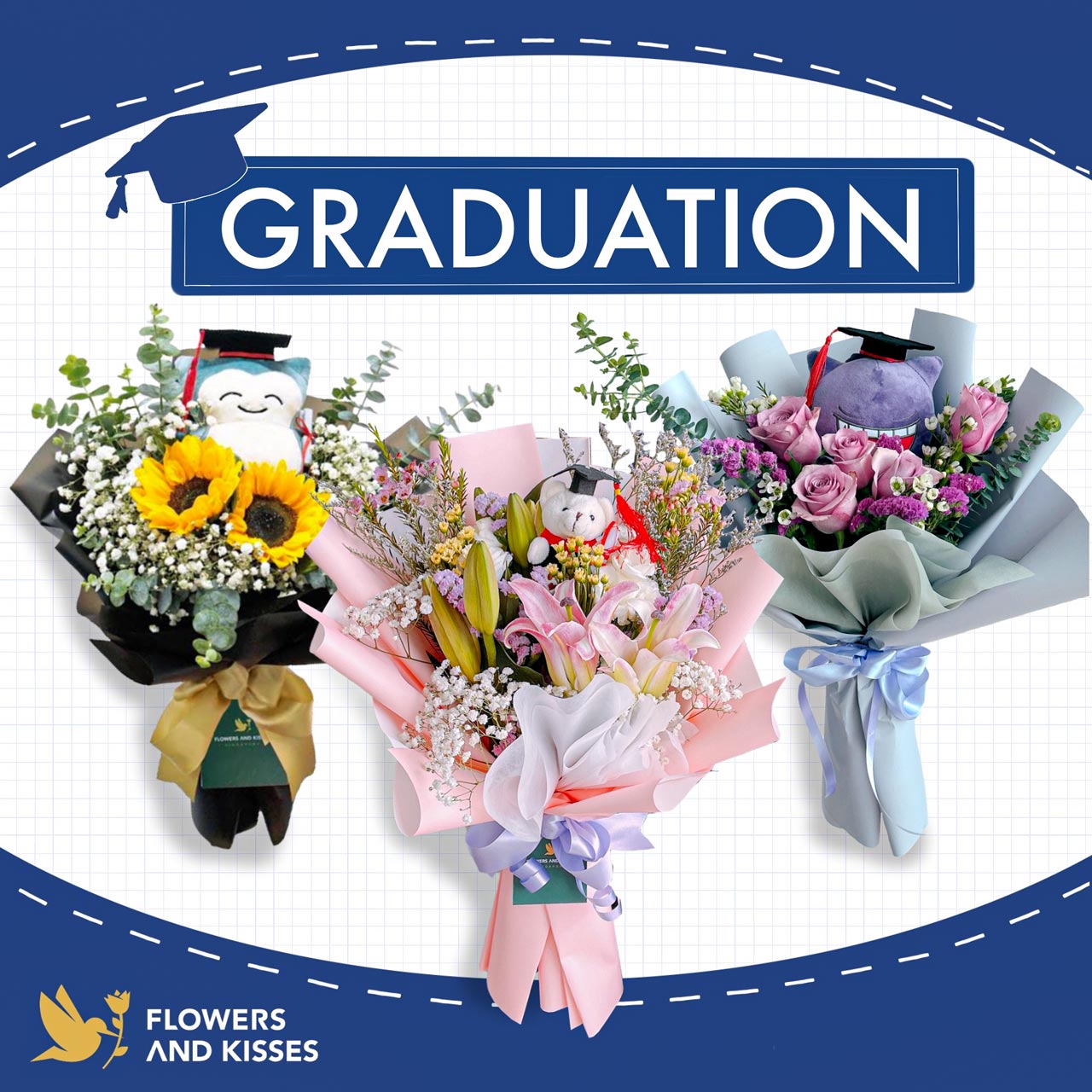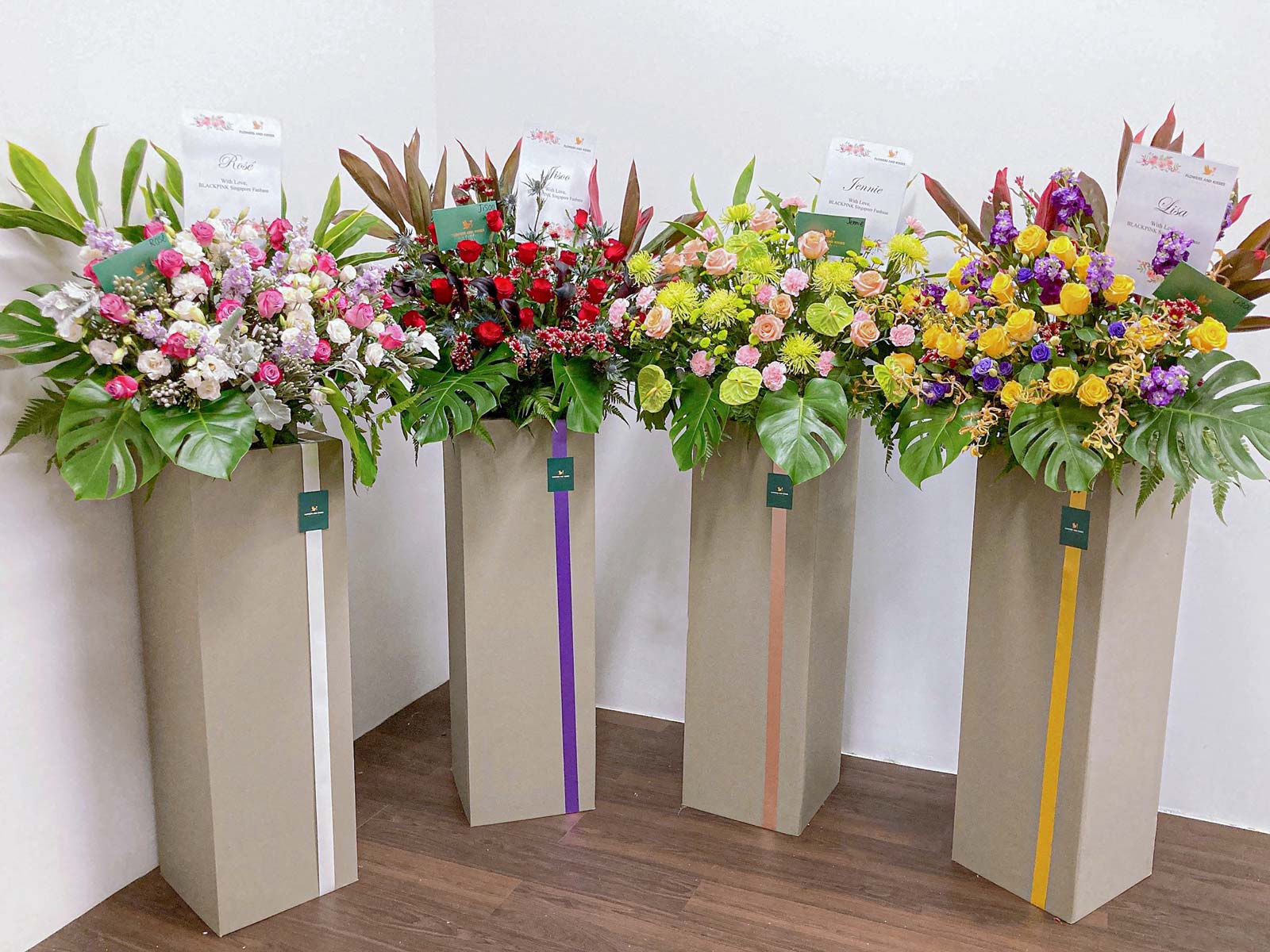Flower
A Guide to Flowers and The Joys of Making Your Own Floral Arrangements
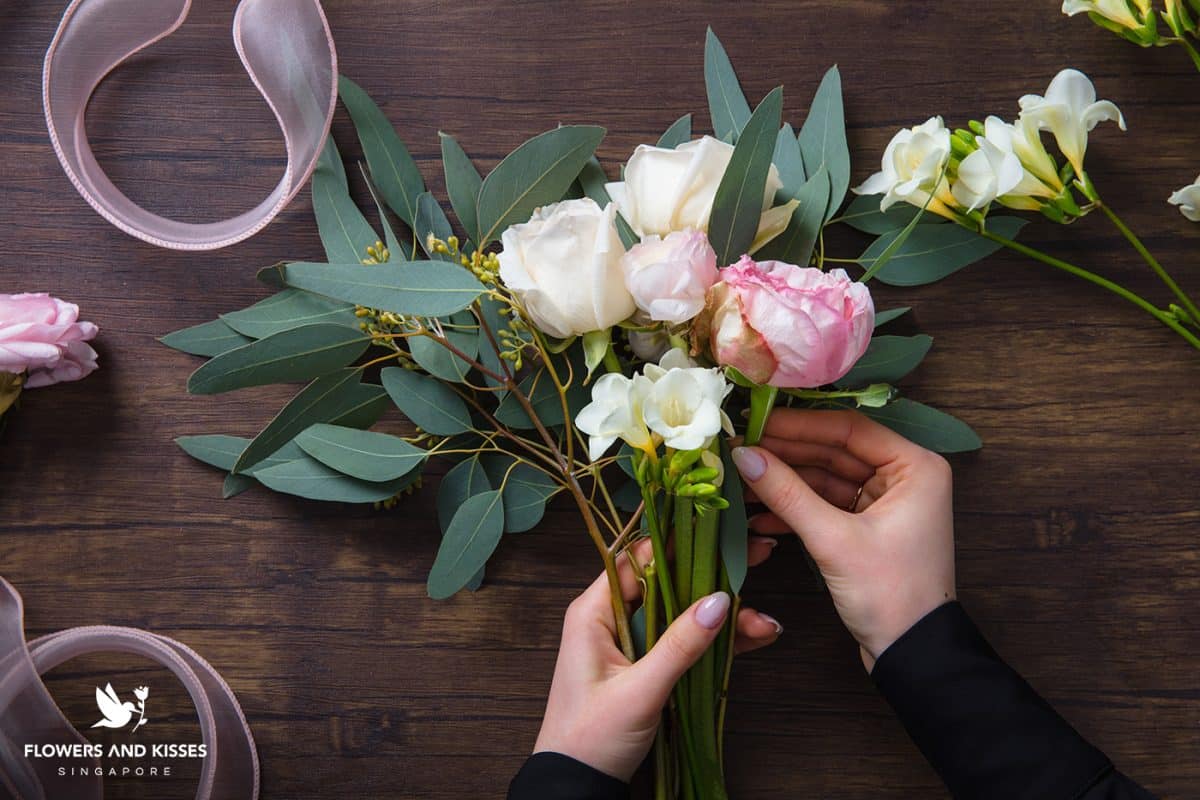
Bringing out the beauty of flowers with an artistic arrangement is the art, and essence of flower arrangements. Flower arrangements play an important role in setting the mood and ambience for any occasion, such as birthdays, weddings, and parties. Additionally, incorporating flowers can also assist with effortlessly brightening up any space, beautifying homes and offices alike when used as centrepieces.
While anyone can simply place a handful of flowers into a vase, there is a little more thought and technique required in the art of flower arranging. Careful planning and preparation is required to create a beautiful piece, on top of ensuring the flowers maintain their colour and freshness. But unknown to many, a classic flower arrangement isn’t difficult to create. Once you learn the basics, flower arranging can be both fun and simple. Flowers and Kisses is an online florist in Singapore, and we’ve put together this guide that dives into the origins of some commonly used blooms in flower arrangements, and tips to master the art such that you too can have gorgeous bouquets displayed all year round!
History of various flowers and their meanings
The concept of using flowers to communicate has been around for thousands of years. It is even believed that during the Victorian era, bouquets were arranged in a way that the combination of flowers portrayed a specific message. However, it was only at the beginning of the 19th century that the language of flowers gained popularity in Europe, with many floriographies written during this period. In this section, we’ll take a look at the histories and symbolisms that come along with some flowers often used for floral arrangements.
Sunflowers
Sunflowers originated in America in 1,000 B.C, and were cultivated then as a valuable food source for centuries. The seeds of the sunflowers were first used by the early Americans, crushing them into flour for bread. It was also eaten as a snack or mixed in with other oats and grains. But sunflowers weren’t just used for food – after discovering how to extract the oil for cooking, the Americans started applying it on their skin and hair for its numerous healthy vitamins. The popularity of the flower then spread with the European exploration of the New World, as the rest of the globe began to appreciate its beauty and sustenance. Artists throughout history were also known to love the sunflower for its unique splendour, with those of the Impressionist era being especially fixated on it.
The sunflower’s name originates from its tendency to reposition itself to face the sun, with the ancient Greek myth of Apollo and Clytie serving as an explanation. In this story, Clytie, a nymph, adored Apollo. At the beginning, he loved her back but soon fell in love with Leucothoe. Out of jealousy, Clytie told Leucothoe’s father of the relationship and he punished her by burying her alive. In anger, Apollo turned Clytie into a flower. But that didn’t stop Clytie from loving him, and she would spend her days watching him as he moved the sun across the sky in his chariot.
Today, sunflowers remain a highly recognisable flower, admired for their sunny charm and disposition. Symbolising adoration and loyalty due to the myth of Apollo and Clytie, sunflower meanings can vary across cultures; in China, people associate sunflowers with long life, good fortune, and vitality. To the Native American groups, sunflowers represent harvest, bounty, and provision because they provided seeds, pigment, and more. And because of their association with the sun, sunflower bouquets are generally a happy flower, the perfect blooms to brighten up someone’s mood.
Roses
According to Greek mythology, the creation of red roses has been linked to Aphrodite, the Goddess of Love. It is believed that when Aphrodite came across her lover Adonis, who was wounded by a wild boar, a mixture of her tears and his blood produced a beautiful red rose bush upon hitting the ground. Further down the line during the Victorian Era, red roses were commonly used to convey messages of love due to romantic gestures and displays of affection being banned. When Shakespeare took to fame, this became a poetic standard and everyone came to know of the red rose as the symbol of love.
Different coloured roses come associated with various meanings. Each colour, and even the shape of the blossom, symbolises a different significance from the giver to the recipient. A red rose bouquet for instance, symbolises romance, love, beauty and courage, while red rosebuds signifies beauty and purity. Yellow roses on the other hand convey friendship and joy, while pink roses indicate appreciation and gratitude. The white rose stands for innocence and purity, and are often seen as part of bridal bouquets.
Baby’s Breath
Originally found in Eurasia, Africa, and Australia, baby’s breaths made its way into America in 1828, when Victorian gardeners preferred snowy white, floral arrangements and gardens. The scientific name for the baby’s breath is gypsophila, which comes from the Greek words gypsos, meaning gypsum. This refers to the plant’s preference for soils rich in gypsum, while the ending of the name stems from phileo, which means to love. While the history of its name is fairly mysterious, some believe it came about to highlight the plant’s small, delicate flowers.
The baby’s breath features a lacy floral canopy that is known to attract a variety of bees, and are drought, heat, and soil tolerant. This flower is a symbol of everlasting love, which is why it’s often included in wedding flowers. Baby’s breath bouquets also represent innocence, which makes it a lovely gift for baby showers and new mothers. It’s one example of a flower that has maintained its popularity in floristry throughout history.
Hydrangeas
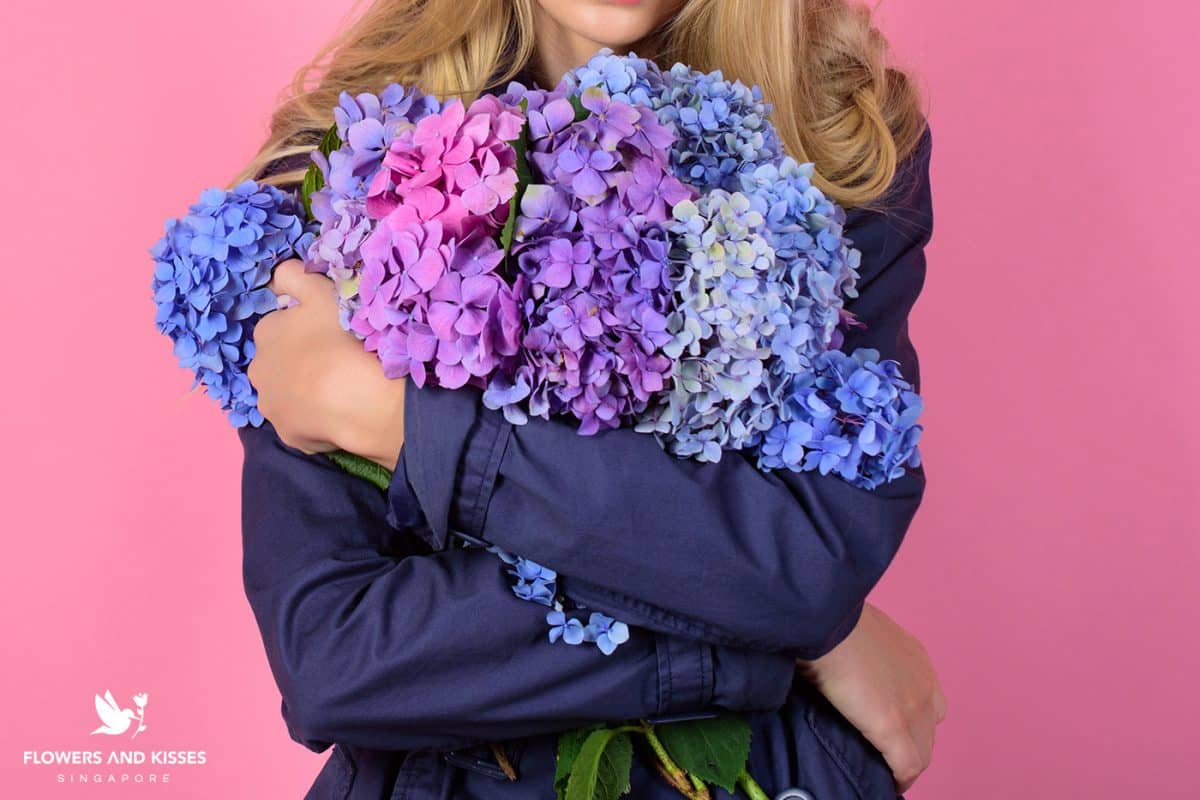
Hydrangeas were first cultivated in Japan and are often referred to as Ajisai. These flowers usually bloom during the rainy season from June to July, and turn places like the Meigetsuin Temple into a mystical, fragrant garden. According to a Japanese legend, the hydrangea became associated with heartfelt emotion, gratitude for understanding, and apology after a Japanese emperor gave them to the family of the girl he loved to make up for neglecting her in favour of business.
The Japanese aren’t the only ones who have enjoyed the sweet scent and vibrant colours of hydrangeas. Ancient fossils dating back 40-65 million years ago show that hydrangeas have been growing in North America for quite some time. In Europe, hydrangeas appeared in 1736 when a colonist brought a North American variety of the flower to England. Today, hydrangeas can be found all over Asia, America and Europe, where they are known also as hortensias.
Hydrangea bouquets typically come in shades of pink, blue, and purple, each with different symbolisms – pink hydrangeas symbolise heartfelt emotion, blue conveys regret and apology, and purple represents a desire to deeply understand someone.
Benefits of making your own floral arrangements
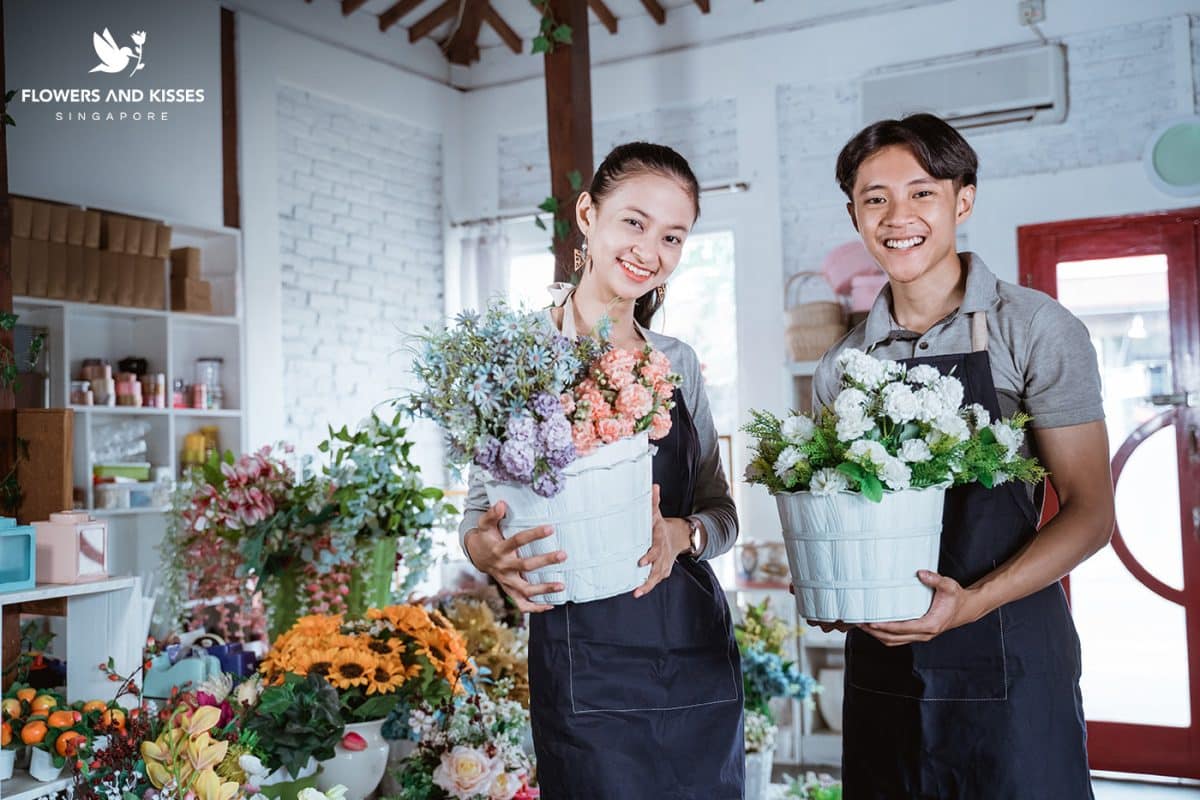
Incorporating some colour and sweet fragrance in your environment through floral displays can serve as a real mood lifter throughout the year. There’s nothing quite like beautiful freshly cut flowers to brighten your living or working spaces. But did you know that making your own floral arrangement also comes with a host of benefits and mood-boosting perks? We take a look at some of these proven benefits below.
Improved mental dexterity
Fine motor skills tend to deteriorate with age as joint stiffness or swelling from arthritis attack the hands, causing fingers to become more rigid with reduced flexibility. The act of cutting and arranging flowers gently engages your joints, and helps to preserve motor function. This leads to improved mental dexterity and muscle memory by engaging finger movements in the hand. Over time, flower arranging can also promote muscle memory, which is beneficial for improving the body-mind connection.
Boosts mood
A 10-month study conducted by Dr. Haviland-Jones of Rutgers University showed that viewing flowers can instantly elevate a person’s mood. During the study, participants were given flowers at random intervals, then asked to report their levels of satisfaction. Almost everyone involved in the study reported feeling increased happiness after receiving flowers, with a substantial number also reporting feelings of excitement and gratitude. This suggests seeing flowers can trigger the release of dopamine and other feel-good chemicals within the brain, with effects so profound that scientists are now exploring the use of flowers as a treatment for depression and anxiety.
Promotes socialisation and connections
Flower arranging is an easy activity to enjoy as a group or even with just one friend. Any hobby that encourages socialisation can be beneficial for reducing the feelings of loneliness and isolation. Additionally, flower arranging is also an activity that fosters inclusivity of all age ranges – enjoy this pastime with friends, family, and even grandparents. Regardless of age or skill levels, flower arranging is a great way to socialise and build connections with those around you.
Tips for making your own floral arrangements at home
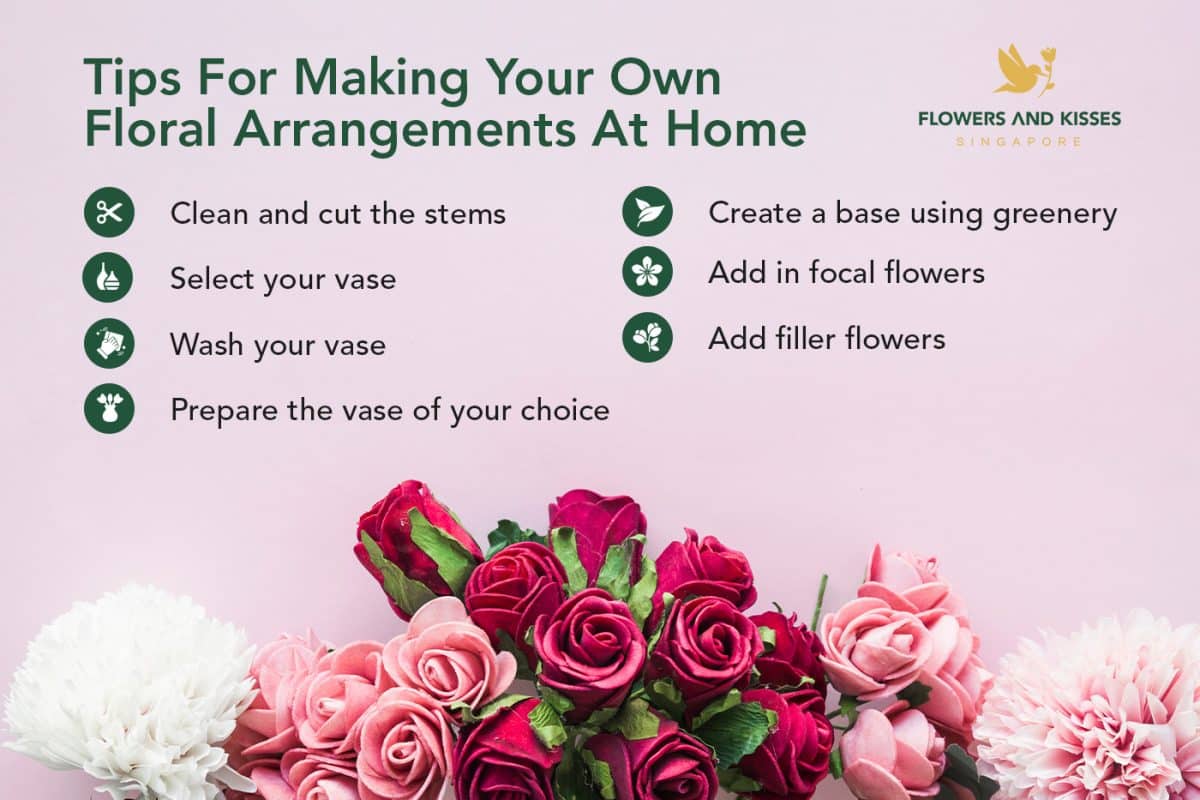
Whether it’s a romantic bundle or a simple low arrangement on your dining table, floral arrangements lend a natural beauty that helps to elevate the interior of your home. But knowing how to properly prepare for your flower arrangement is an aspect that could cause a tinge of stress in some. Looking to create an arrangement for your next dinner party, or bring a dose of colour and cheer to your home? Read on to learn some tricks to ensure the perfect bouquet!
Clean and cut the stems
You might be tempted to begin arranging immediately after arriving home with your flowers. However, there are some important steps needed to ensure the longevity of your blooms. Begin by removing extra leaves and damaged petals from stems, and cut off any unwanted buds.
Once the stems have been cleaned up, make a fresh diagonal cut to the bottom of the stems. Doing so helps ensure there is maximum surface area for water absorption. Place the flowers in water immediately after trimming as some stems quickly form a ‘scab’ over fresh cuts when exposed to air, making it harder for absorption of water later on.
Select your vase
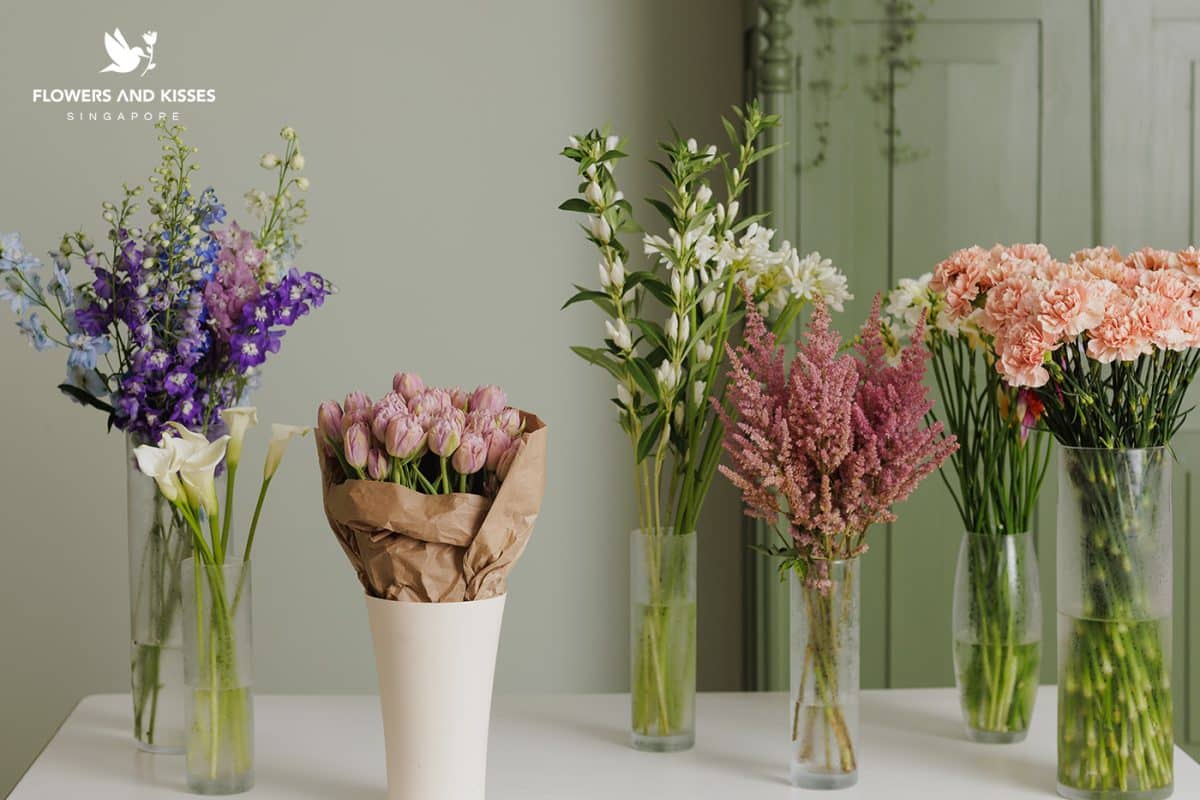
Take into consideration the type of flowers you will be using when selecting a vase or container for your floral display. Flowers like tulips typically require the support of a straight-sided vase, while tall branches or top-heavy flowers might require a weighted vessel. Apart from traditional vases, you may also consider housing your flower arrangements in woven baskets for added texture. To hold water in and keep the flowers in place, place the flowers in a plastic container such as a repurposed plastic water bottle. Fill with moss around the container to disguise it inside the basket if needed.
Wash your vase
It is crucial to wash your vase between bouquets if you use the same vase repeatedly for fresh flowers. This is because bacteria caused by the decay from your last arrangement can linger, causing your new flowers to have a much shorter vase life than they normally would. Keep in mind to wash your vessel of choice with soap and hot water instead of just a casual rinse to prevent the growth of bacteria or mould.
Prepare the vase of your choice
Floral displays without a sturdy foundation are more likely to fall apart. Therefore, the most important aspect of flower arrangement doesn’t actually involve the flowers, but revolves more around how well your vessel has been prepped. To keep the flowers in place, create a grid over the mouth of your vase using floral tape, then stick the stems of the flowers through the holes of the grid.
Create a base using greenery
The best way to start on your arrangement is by using greenery as a base. Incorporate two to three varieties such as fern or eucalyptus, criss-crossed along the edge of the vessel. Create an inverted triangular shape using the stems of the greenery. This provides your arrangement with both a horizontal and a vertical presence, and also helps ground the overall arrangement look.
Add in focal flowers
Focal flowers are usually the largest blooms or those with an unusual colour or texture. Make sure to add in odd numbers for a more natural look, and avoid placing the flowers in a way where they are sticking straight out on the sides – this will cause them to look droopy and heavy, rather than strong and perky.
Add filler flowers
After you’ve included the focal flowers for your arrangement, add on smaller flowers and textural elements to fill around the focal flowers. Visualise the shape of your arrangement as a dome, where all angles should be filled, completing the final look. Combine smaller flowers in groups of three or five to create clusters, much like what occurs in nature. Before displaying, give your flower arrangement a light spritz of water to mimic the look of fresh dew, and refill the vase with water as needed to keep the flowers hydrated and fresh.
Types of classic flower arrangements
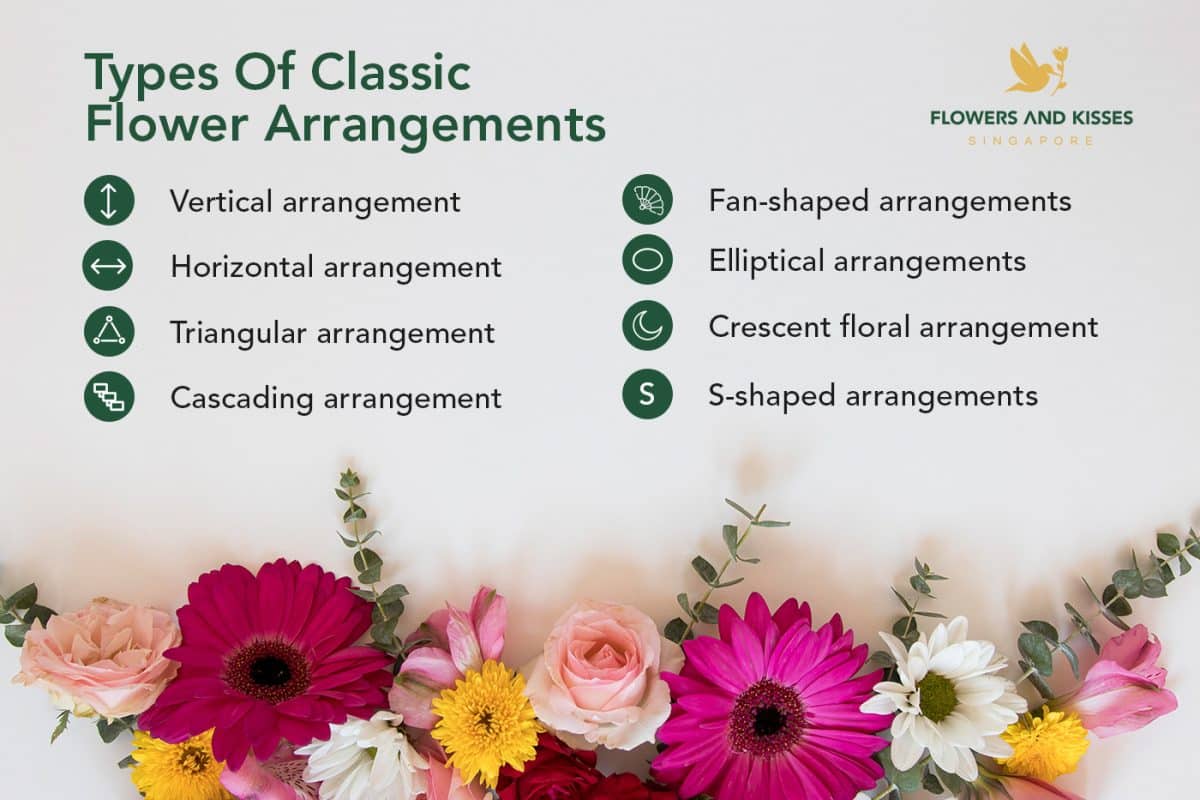
It pays to know the differences between different arrangements whether you’re planning on surprising a special someone with fresh flowers, or simply just love the look of a floral centrepiece on your dining table. We explore the different variations in this section.
Vertical arrangement
One of the most used flower arrangements in hand bouquets as well as vases, vertical flower arrangements are simple yet sophisticated in nature. Long-stemmed flowers, such as roses, tulips, and carnations, are typically used in this design. The blooms can be nestled in a stylish vase or presented as a sleek flower bouquet. Vertical flower arrangements are also used as dramatic accent pieces in a spacious area like hotel lobbies or receptions.
Horizontal arrangement
Horizontal arrangements require a wider space for displaying, and make the dreamiest tablescapes for special occasions like weddings. Arranged in rows or a zigzag manner, loose, floral designs with several combinations of flora and foliage sprawling over long tables is often created. In addition, the low height of this flower arrangement makes it suitable for seated guests facing an audience or to socialise without anything blocking their view.
Triangular arrangement
If you love all things unique, you may find yourself drawn to the beautiful triangular flower arrangement. These floral displays usually come with a big flower in the middle, with small flowers accordingly placed on the sides to form a triangular arrangement.
Cascading arrangement
As its name implies, the distinct features of a cascading arrangement are flowers and foliage that beautifully trail down, creating a romantic wildflower kind of effect. Most typically used as hand bouquets in weddings, it has a distinct, unstructured look that many brides love.
Fan-shaped arrangements
One of the most commonly used classic flower arrangement styles, the fan-shaped design focuses on the volume and size of the arrangement. The focal flowers are placed in the centre while long-stemmed foliage or filler flowers are artfully arranged in an outward manner, forming the shape of a fan. This design is meant for flowers with longer stems, and used primarily for entrance decorations.
Elliptical arrangements
Elliptical flower arrangements are used to highlight brighter coloured flowers, often showcasing their allure. This design is one of the easiest for beginners due to its minimalistic nature, and created with any colour palette as long as the flowers are in full bloom. Great for bringing out the natural beauty of flowers, without an overbearing display, flowers such as lilies, lotus, sunflowers, and roses are often utilised for this purpose.
Crescent floral arrangement
The crescent floral arrangement mimics the shape of a crescent, featuring a graceful curve line and a refined aura created by an asymmetrical arrangement. This floral design is especially popular in Japanese Ikebana. However, we often find a similar way of arrangement in Western designs such as European and American floral arrangements as well. Also known as the C type arrangement, these floral pieces serve as beautiful gifts to symbolise a joyous event such as a baby shower.
S-shaped arrangements
This design extends the idea of the half-moon shape in the crescent style, where floral elements curve in from the top and sweep down to suggest a smooth, flowing ‘S’ shape. In addition, leaves are incorporated as fillers to make the flowers appear more prominent, resulting in a classy flower arrangement that captures attention when displayed.
Questions you may have
We conclude this guide with some questions you might have with regards to your flowers.
How long can flowers last?
Our flowers can be kept fresh for at least 2-3 days. To prolong the vase life of your flowers, make sure to place them in a cool and dry environment, away from direct sunlight and heat. We also recommend keeping the flowers in your refrigerator if there is available space there.
How should I care for my flowers?
For wrapped bouquets, remove the flowers from the packaging and place in a vase of clean water. Remove any fading blooms and yellowing leaves that appear, and add fresh water in the vase, every day.
How do I get rid of pollen stains?
For small pollen stains, you may be able to remove most of it simply by shaking the fabric vigorously. If some of the stain remains, hold a small, handheld vacuum one centimetre from your clothing and suck up any loose pollen. Gently place sticky tape over and rip off after.
For larger stains, rubbing alcohol can be a very effective stain remover – all you have to do is apply to the stain and blot gently.
Do you charge for delivery?
At Flowers and Kisses, all our bouquets and floral products come with complimentary same-day fresh flower delivery, with no minimum spending to qualify for free shipping.
Conclusion
Flower arrangements can come in different designs and endless combinations, tailored to suit all occasions. Follow these tips, and you too can create something beautiful and personalised for anytime of the year!
If you’d like to know more about decorating with flowers, our team at Flowers and Kisses are more than happy to help you out. Reach out and speak with us today to find out more!

